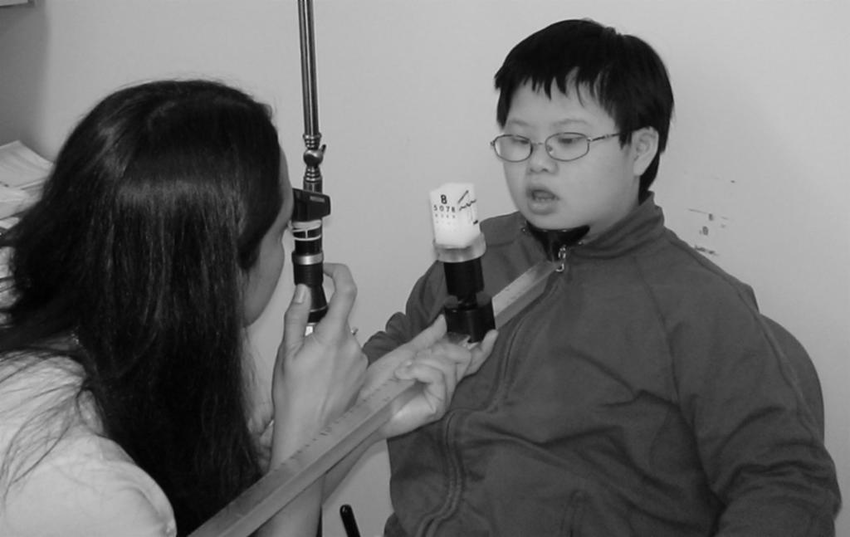Dynamic retinoscopy
Dynamic retinoscopy is a method to check the accommodation effectiveness in the eyes of patient while he is given a near target. The purpose of dynamic retinoscopy is to check the accommodation facility of the patient. It is performed after the patient is done with subjective retinoscopy.
When the method of subjective retinoscopy is completed?
It is completed when the refractive error in the pupil of the eye in the form of pupillary reflex is neutralized. Generally it is neutralized by giving the right lenses. Now the patient is required to check his accommodative facility. For this purpose we will be sitting at the arm distance length in front of patient after neutralizing his refractive error with the help of retinoscope. Now the examiner or optometrist request the patient to shift his gaze from the distant target to the near target.
Stimulation of pupillary reflex in dynamic retinoscopy
This shift of gaze will stimulate the accommodative facility as the patient is doing near work now. This will shift the neutralization point into against pupillary reflex. Now the accommodative facility status is determined whether is normal or accommodation is lag or lead.
Methods to perform dynamic retinoscopy
There are different methods to perform dynamic retinoscopy. Following are the methods
- MEM
- Nott’s retinoscopy
- Bell retinoscopy
- Book retinoscopy
- Cross retinoscopy
MEM (Monocular Estimated Method) Retinoscopy
- This type of dynamic retinoscopy has to be performed at a near distance of 40cm in adults and at a Harmon distance for children. It is useful to detect accommodative response.
- For this purpose after performing the subjective retinoscopy, the patient is given a near target.
- We attach fixation card with the retinoscope and ask patient to look at it and focus it.
- Now we chose vertical streak of retinoscope to enter the eye of patient whose eyes have become emmetropic after correcting the refractive error.
- While the patient fixating at a near distance, see if the reflex is still neutralized or showing With or Against Movement.
- With reflex shows lag of accommodation and against reflex shows lead of accommodation.
- Neutralize this error monocularly by putting lens in front of eye not more than one second.
- If the lag of accommodative response is neutralized above +0.75D then this shows near esophoria, under corrected hyperopia or over corrected myopia.
- If the reflex is neutralized below than +0.25D then it is the manifestation of accommodation spasm or under corrected myopia or near exophoria.

Nott’s method of dynamic retinoscopy
- In Nott’s method, near target is given to the patient and the room is illuminated.
- The patient is wearing the prescription for distance to achieve emmetropia.
- The patient should see the near target monocularly.
- Note that the near target and the retinoscopy are equidistant from the eyes of the patient.
- Now observe the movement of reflex when the patient is exerting accommodation while focusing near target.
- If the reflex shows against movement then the patient is exerting over accommodation and accommodation is lead.
- Move the retinoscope towards the eyes of patient without moving the near target.
- Note that where the reflex is neutralized.
- If the patient shows with reflex movement, it means that he is under accommodating and accommodation is lag. Now move the retinoscope behind the target and get the neutralization point.
- Note the distance between the target and neutralization point. The reverse of this distance is amplitude of lag or lead of accommodation.

Modified bell retinoscopy
- In modified bell retinoscopy, we move the target towards the patients and do not move the retinoscope.
- This is performed on the children who cannot corporate with MEM and with Nott retinoscopy.
- The target is attached to the measuring tape and is easily moveable over it.
- The distance among the retinoscope, reflex and near targets are calculated to find out accommodative demand and accommodation lag.
- The distance between the child and retinoscope is fixed
Book retinoscopy
- In this type of dynamic retinoscopy, the person is given a near target of the book.
- It is the objective method to find the refractive errors in the eyes of patient as manifested at the end in MEM retinoscopy mentioned above.
- The examiner watches the retinoscopy reflex behind the book and observes the brightness and speed of the reflex.
Cross retinoscopy
- We generally perform this in presbyopes.
- In this type of dynamic retinoscopy method, the patient after performing the subjective refraction is given near target at about 40 cm.
- The examiner adds plus lenses until the error is neutralized which is at first shows with reflex movement.
- This is not an appreciable way to find the exact near aid for presbyopes.
Founder of EyesMatterMost- an optometry student who loves talking about eyes. I tend to cover topics related to optometry, ophthalmology, eye health, eyecare, eye cosmetics and everything in between. This website is a medium to educate my readers everything related to eyes.
